2002 MERCEDES-BENZ CLK-CLASS service
[x] Cancel search: servicePage 273 of 341
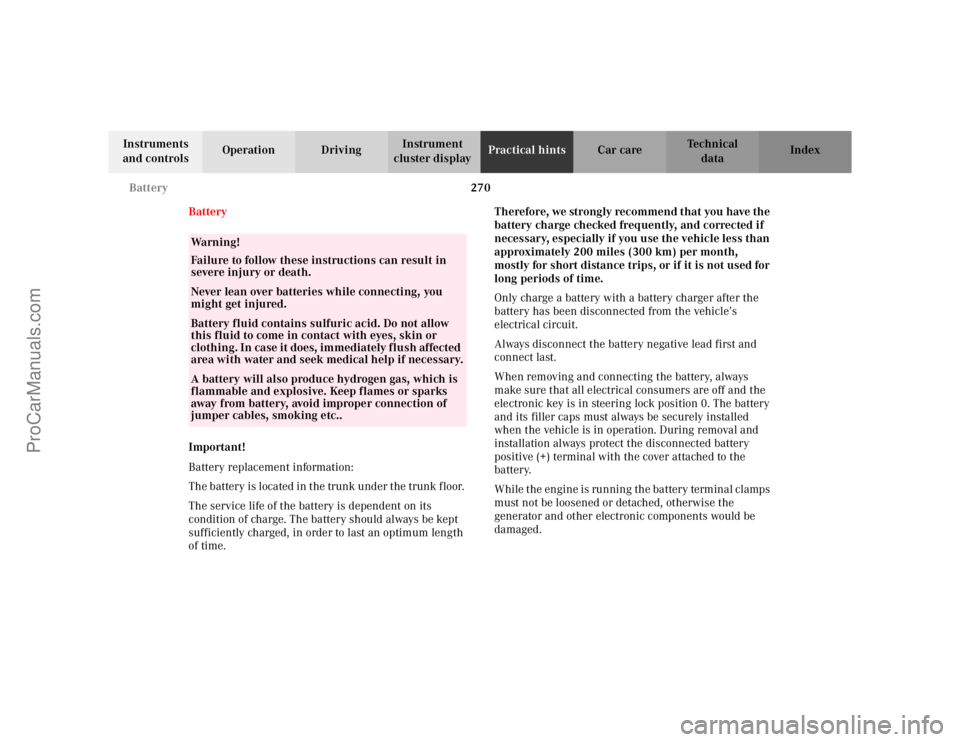
270 Battery
Te ch n i c a l
data Instruments
and controlsOperation DrivingInstrument
cluster displayPractical hintsCar care Index
Battery
Important!
Battery replacement information:
The battery is located in the trunk under the trunk floor.
The service life of the battery is dependent on its
condition of charge. The battery should always be kept
sufficiently charged, in order to last an optimum length
of time.Therefore, we strongly recommend that you have the
battery charge checked frequently, and corrected if
necessary, especially if you use the vehicle less than
approximately 200 miles (300 km) per month,
mostly for short distance trips, or if it is not used for
long periods of time.
Only charge a battery with a battery charger after the
battery has been disconnected from the vehicle’s
electrical circuit.
Always disconnect the battery negative lead first and
connect last.
When removing and connecting the battery, always
make sure that all electrical consumers are off and the
electronic key is in steering lock position 0. The battery
and its filler caps must always be securely installed
when the vehicle is in operation. During removal and
installation always protect the disconnected battery
positive (+) terminal with the cover attached to the
battery.
While the engine is running the battery terminal clamps
must not be loosened or detached, otherwise the
generator and other electronic components would be
damaged.
Wa r n i n g !
Failure to follow these instructions can result in
severe injury or death.Never lean over batteries while connecting, you
might get injured.Battery fluid contains sulfuric acid. Do not allow
this fluid to come in contact with eyes, skin or
clothing. In case it does, immediately flush affected
area with water and seek medical help if necessary.A battery will also produce hydrogen gas, which is
flammable and explosive. Keep flames or sparks
away from battery, avoid improper connection of
jumper cables, smoking etc..
ProCarManuals.com
Page 310 of 341
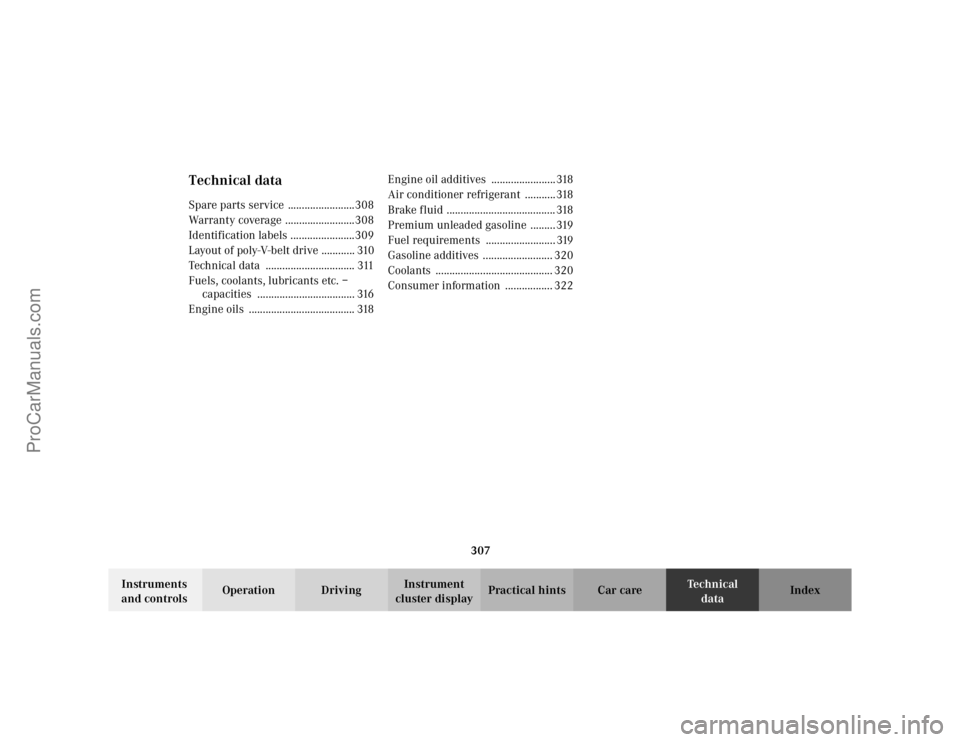
307
Te ch n i c a l
data Instruments
and controlsOperation DrivingInstrument
cluster displayPractical hints Car care Index
Technical dataSpare parts service ........................308
Warranty coverage .........................308
Identification labels .......................309
Layout of poly-V-belt drive ............ 310
Technical data ................................ 311
Fuels, coolants, lubricants etc. –
capacities ................................... 316
Engine oils ...................................... 318Engine oil additives ....................... 318
Air conditioner refrigerant ........... 318
Brake fluid ....................................... 318
Premium unleaded gasoline ......... 319
Fuel requirements ......................... 319
Gasoline additives ......................... 320
Coolants .......................................... 320
Consumer information ................. 322
ProCarManuals.com
Page 311 of 341
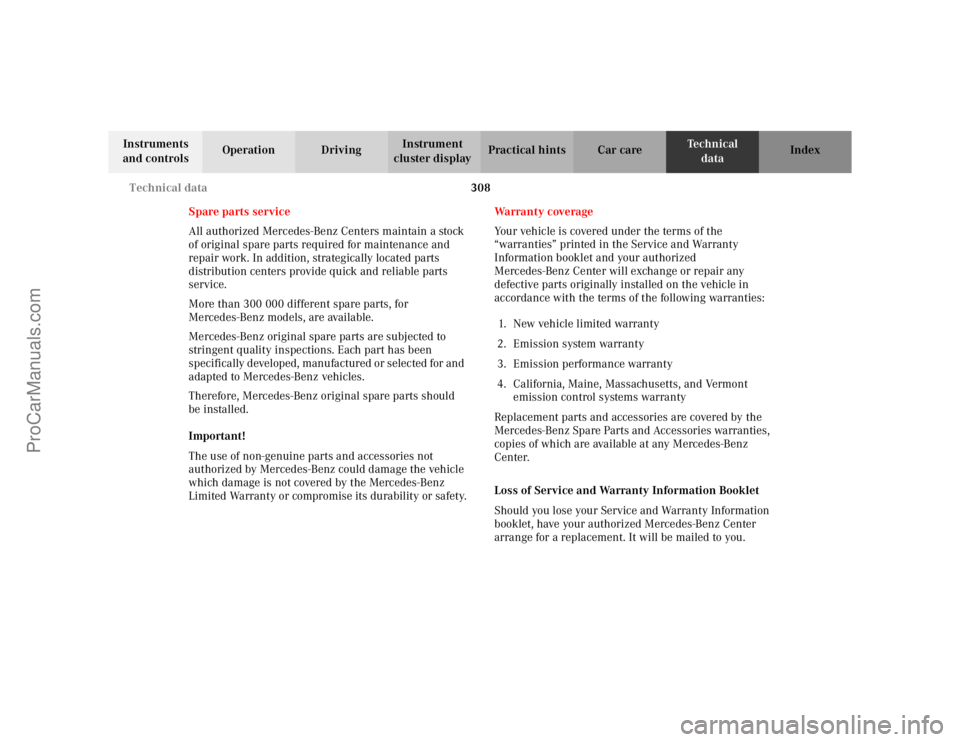
308 Technical data
Te ch n i c a l
data Instruments
and controlsOperation DrivingInstrument
cluster displayPractical hints Car care Index
Spare parts service
All authorized Mercedes-Benz Centers maintain a stock
of original spare parts required for maintenance and
repair work. In addition, strategically located parts
distribution centers provide quick and reliable parts
service.
More than 300 000 different spare parts, for
Mercedes-Benz models, are available.
Mercedes-Benz original spare parts are subjected to
stringent quality inspections. Each part has been
specifically developed, manufactured or selected for and
adapted to Mercedes-Benz vehicles.
Therefore, Mercedes-Benz original spare parts should
be installed.
Important!
The use of non-genuine parts and accessories not
authorized by Mercedes-Benz could damage the vehicle
which damage is not covered by the Mercedes-Benz
Limited Warranty or compromise its durability or safety.Warranty coverage
Your vehicle is covered under the terms of the
“warranties” printed in the Service and Warranty
Information booklet and your authorized
Mercedes-Benz Center will exchange or repair any
defective parts originally installed on the vehicle in
accordance with the terms of the following warranties:
1. New vehicle limited warranty
2. Emission system warranty
3. Emission performance warranty
4. California, Maine, Massachusetts, and Vermont
emission control systems warranty
Replacement parts and accessories are covered by the
Mercedes-Benz Spare Parts and Accessories warranties,
copies of which are available at any Mercedes-Benz
Center.
Loss of Service and Warranty Information Booklet
Should you lose your Service and Warranty Information
booklet, have your authorized Mercedes-Benz Center
arrange for a replacement. It will be mailed to you.
ProCarManuals.com
Page 319 of 341
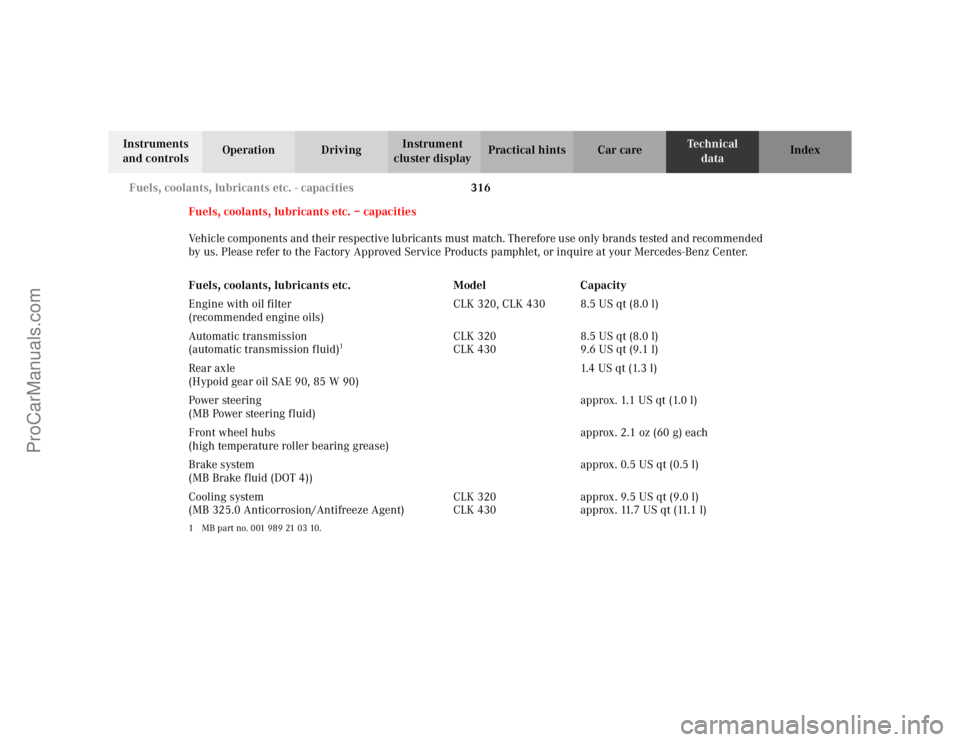
316 Fuels, coolants, lubricants etc. - capacities
Te ch n i c a l
data Instruments
and controlsOperation DrivingInstrument
cluster displayPractical hints Car care Index
Fuels, coolants, lubricants etc. – capacities
Vehicle components and their respective lubricants must match. Therefore use only brands tested and recommended
by us. Please refer to the Factory Approved Service Products pamphlet, or inquire at your Mercedes-Benz Center.
Fuels, coolants, lubricants etc. Model Capacity
Engine with oil filter
(recommended engine oils)CLK 320, CLK 430 8.5 US qt (8.0 l)
Automatic transmission
(automatic transmission fluid)
1
CLK 320
CLK 4308.5 US qt (8.0 l)
9.6 US qt (9.1 l)
Rear axle
(Hypoid gear oil SAE 90, 85 W 90)1.4 US qt (1.3 l)
Power steering
(MB Power steering fluid)approx. 1.1 US qt (1.0 l)
Front wheel hubs
(high temperature roller bearing grease)approx. 2.1 oz (60 g) each
Brake system
(MB Brake fluid (DOT 4))approx. 0.5 US qt (0.5 l)
Cooling system
(MB 325.0 Anticorrosion/Antifreeze Agent)CLK 320
CLK 430approx. 9.5 US qt (9.0 l)
approx. 11.7 US qt (11.1 l)
1 MB part no. 001 989 21 03 10.
ProCarManuals.com
Page 321 of 341

318 Fuels, coolants, lubricants etc.
Te ch n i c a l
data Instruments
and controlsOperation DrivingInstrument
cluster displayPractical hints Car care Index
Engine oils
Engine oils are specifically tested for their suitability in
our engines. Therefore, use only engine oils
recommended by Mercedes-Benz. Information on
recommended brands is available in the Factory
Approved Service Products pamphlet or at your
authorized Mercedes-Benz Center.
Please follow Service Booklet recommendations for
scheduled oil changes. Failure to do so could result in
engine damage not covered by the Mercedes-Benz
Limited Warranty.
Engine oil additives
Do not blend oil additives with engine oil. They may be
harmful to the engine operation.
Damage or malfunctions resulting from blending oil
additives are not covered by the Mercedes-Benz Limited
Warranty.Air conditioner refrigerant
R-134a (HFC) refrigerant and special PAG lubricating oil
is used in the air conditioner system.
Never use R-12 (CFC) or mineral-based lubricating oil,
otherwise damage to the system will occur.
Brake fluid
During vehicle operation, the boiling point of the brake
fluid is continuously reduced through the absorption of
moisture from the atmosphere. Under extremely hard
operating conditions, this moisture content can lead to
the formation of bubbles in the system thus reducing
the system’s efficiency.
The brake fluid must therefore be replaced every two
years, preferably in the spring.
It is recommended to use only brake fluid approved by
Mercedes-Benz. Your authorized Mercedes-Benz Center
will provide you with additional information.
ProCarManuals.com
Page 323 of 341
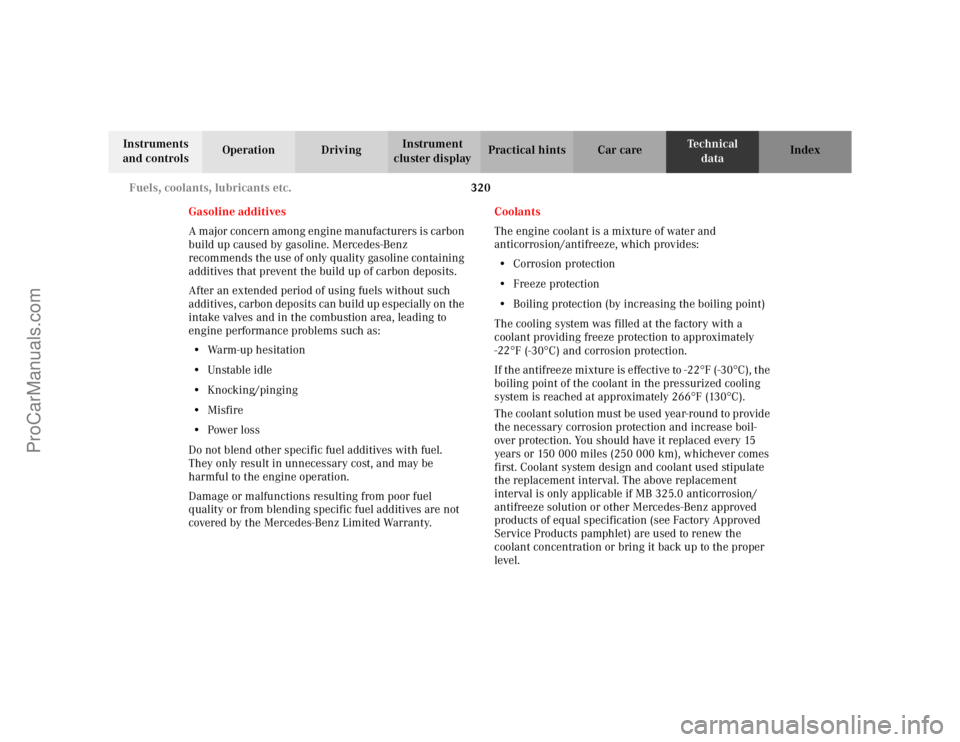
320 Fuels, coolants, lubricants etc.
Te ch n i c a l
data Instruments
and controlsOperation DrivingInstrument
cluster displayPractical hints Car care Index
Gasoline additives
A major concern among engine manufacturers is carbon
build up caused by gasoline. Mercedes-Benz
recommends the use of only quality gasoline containing
additives that prevent the build up of carbon deposits.
After an extended period of using fuels without such
additives, carbon deposits can build up especially on the
intake valves and in the combustion area, leading to
engine performance problems such as:
•Warm-up hesitation
•Unstable idle
•Knocking/pinging
•Misfire
•Power loss
Do not blend other specific fuel additives with fuel.
They only result in unnecessary cost, and may be
harmful to the engine operation.
Damage or malfunctions resulting from poor fuel
quality or from blending specific fuel additives are not
covered by the Mercedes-Benz Limited Warranty.Coolants
The engine coolant is a mixture of water and
anticorrosion/antifreeze, which provides:
•Corrosion protection
•Freeze protection
•Boiling protection (by increasing the boiling point)
The cooling system was filled at the factory with a
coolant providing freeze protection to approximately
-22
°F (-30
°C) and corrosion protection.
If the antifreeze mixture is effective to -22
°F (-30
°C), the
boiling point of the coolant in the pressurized cooling
system is reached at approximately 266
°F (130
°C).
The coolant solution must be used year-round to provide
the necessary corrosion protection and increase boil-
over protection. You should have it replaced every 15
years or 150 000 miles (250 000 km), whichever comes
first. Coolant system design and coolant used stipulate
the replacement interval. The above replacement
interval is only applicable if MB 325.0 anticorrosion/
antifreeze solution or other Mercedes-Benz approved
products of equal specification (see Factory Approved
Service Products pamphlet) are used to renew the
coolant concentration or bring it back up to the proper
level.
ProCarManuals.com
Page 324 of 341
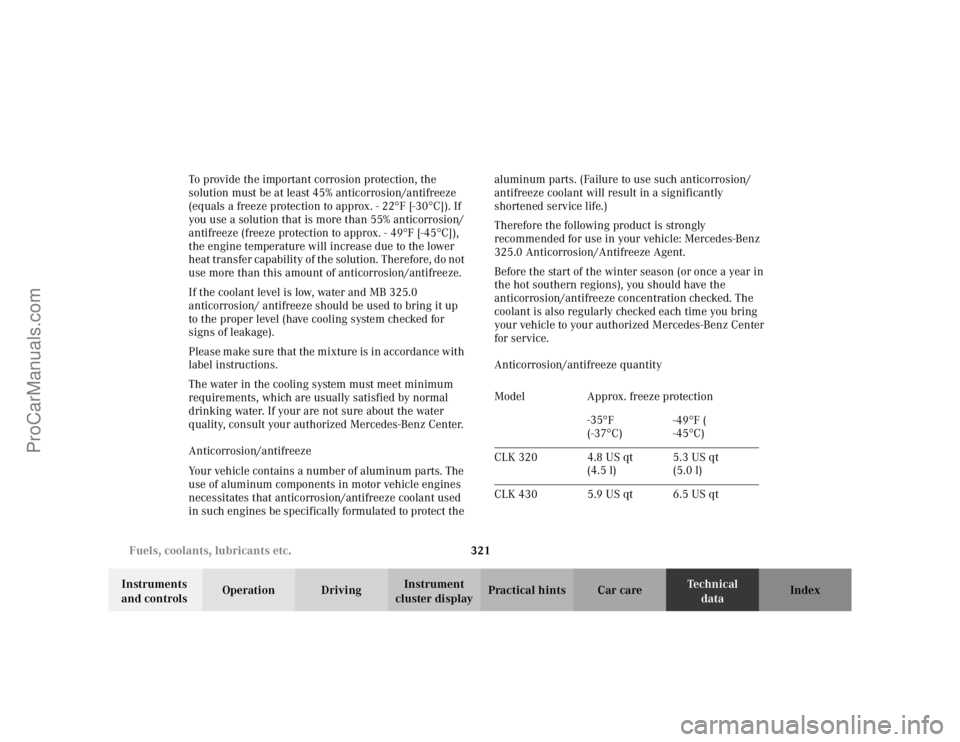
321 Fuels, coolants, lubricants etc.
Te ch n i c a l
data Instruments
and controlsOperation DrivingInstrument
cluster displayPractical hints Car care Index To provide the important corrosion protection, the
solution must be at least 45% anticorrosion/antifreeze
(equals a freeze protection to approx. - 22
°F [-30
°C]). If
you use a solution that is more than 55% anticorrosion/
antifreeze (freeze protection to approx. - 49
°F [-45
°C]),
the engine temperature will increase due to the lower
heat transfer capability of the solution. Therefore, do not
use more than this amount of anticorrosion/antifreeze.
If the coolant level is low, water and MB 325.0
anticorrosion/ antifreeze should be used to bring it up
to the proper level (have cooling system checked for
signs of leakage).
Please make sure that the mixture is in accordance with
label instructions.
The water in the cooling system must meet minimum
requirements, which are usually satisfied by normal
drinking water. If your are not sure about the water
quality, consult your authorized Mercedes-Benz Center.
Anticorrosion/antifreeze
Your vehicle contains a number of aluminum parts. The
use of aluminum components in motor vehicle engines
necessitates that anticorrosion/antifreeze coolant used
in such engines be specifically formulated to protect the aluminum parts. (Failure to use such anticorrosion/
antifreeze coolant will result in a significantly
shortened service life.)
Therefore the following product is strongly
recommended for use in your vehicle: Mercedes-Benz
325.0 Anticorrosion/Antifreeze Agent.
Before the start of the winter season (or once a year in
the hot southern regions), you should have the
anticorrosion/antifreeze concentration checked. The
coolant is also regularly checked each time you bring
your vehicle to your authorized Mercedes-Benz Center
for service.
Anticorrosion/antifreeze quantity
Model Approx. freeze protection
-35
°F
(-37°C)-49
°F (
-45°C)
CLK 320 4.8 US qt
(4.5 l)5.3 US qt
(5.0 l)
CLK 430 5.9 US qt 6.5 US qt
ProCarManuals.com
Page 325 of 341
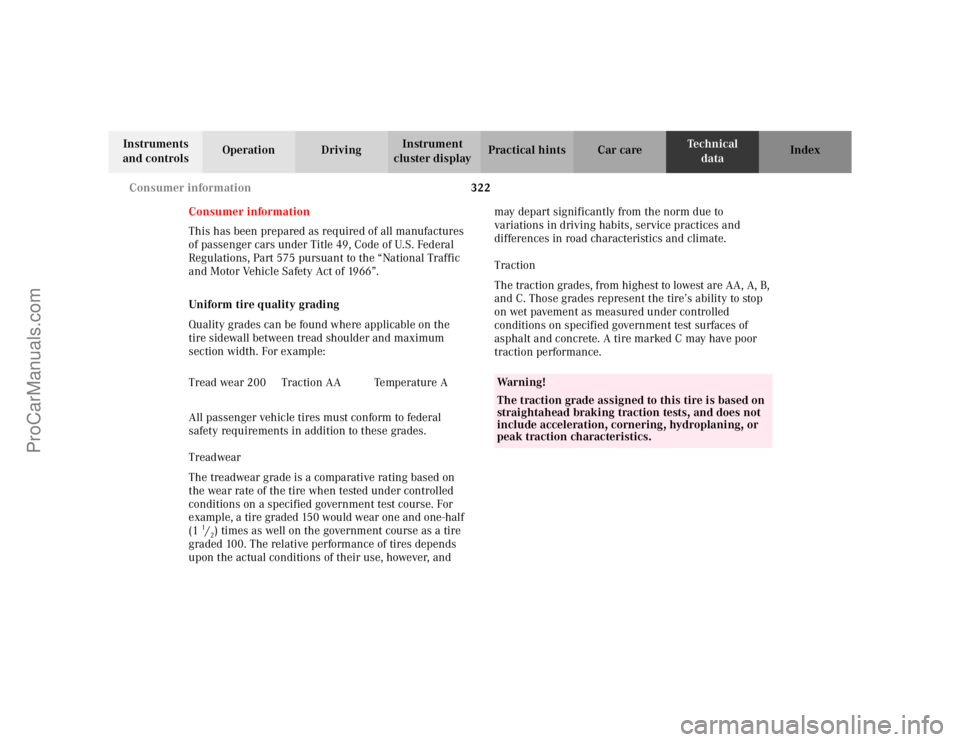
322 Consumer information
Te ch n i c a l
data Instruments
and controlsOperation DrivingInstrument
cluster displayPractical hints Car care Index
Consumer information
This has been prepared as required of all manufactures
of passenger cars under Title 49, Code of U.S. Federal
Regulations, Part 575 pursuant to the “National Traffic
and Motor Vehicle Safety Act of 1966”.
Uniform tire quality grading
Quality grades can be found where applicable on the
tire sidewall between tread shoulder and maximum
section width. For example:
All passenger vehicle tires must conform to federal
safety requirements in addition to these grades.
Treadwear
The treadwear grade is a comparative rating based on
the wear rate of the tire when tested under controlled
conditions on a specified government test course. For
example, a tire graded 150 would wear one and one-half
(1
1/2) times as well on the government course as a tire
graded 100. The relative performance of tires depends
upon the actual conditions of their use, however, and may depart significantly from the norm due to
variations in driving habits, service practices and
differences in road characteristics and climate.
Traction
The traction grades, from highest to lowest are AA, A, B,
and C. Those grades represent the tire’s ability to stop
on wet pavement as measured under controlled
conditions on specified government test surfaces of
asphalt and concrete. A tire marked C may have poor
traction performance.
Tread wear 200 Traction AA Temperature A
Wa r n i n g !
The traction grade assigned to this tire is based on
straightahead braking traction tests, and does not
include acceleration, cornering, hydroplaning, or
peak traction characteristics.
ProCarManuals.com